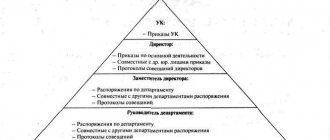Why do you need document numbering?
In small businesses, the volume of personnel documentation is limited. Therefore, all papers can be easily disassembled if necessary. However, if the company has more than a hundred employees, documents will be processed almost every day. For operational orientation in them, numbering is needed. It solves the following problems:
- Quickly search for the required act.
- Conveniently find connections between several documents (for example, between an order to reduce staff and an order to terminate an employment agreement).
- Ensuring proper storage of documentation.
- Systematization of acts based on their content.
- Creating a procedure for registering papers.
- Simplifying the classification of documents when registering them for storage.
- Dividing orders into groups.
Each document has its own shelf life. Only after this period has expired can the paper be destroyed. Numbering is also a tool for indicating storage periods.
How to keep a log of orders ?
What does number assignment mean?
Numbering is the process of assigning a specific number to a document. The procedure involves distinguishing between papers with different shelf life:
- Long-term: 50 or 75 years.
- Short term: 1 or 5 years.
Document numbers are complex, that is, they contain numbers and letters. The need for complex numbers is due to the wide variety of papers. Every year the enterprise must update the calculation procedure. At the beginning of the year, the numbers of new securities begin with the number 1.
Question: Is it necessary to enter letter indices in the numbering of orders for personnel on incentives and penalties? Is it possible to use only numbers to indicate the order number for personnel? View answer
The order of numbering of orders in personnel records management
Numbering of orders in personnel records management is an integral attribute of the document flow of any organization. From our article, the reader will learn why order numbering is necessary, what options for organizing personnel document flow exist, and how to assign a number to an order.
Legislative basis for organizing document flow in an enterprise
The activities of each institution are accompanied by the preparation of a certain number of documents. Even if the company is not particularly active, its document flow consists of official papers on the creation and registration of the enterprise, documentation conveying procedures for the employment and dismissal of workers, and, of course, orders as expressions of will and instructions from the management of the enterprise on a variety of occasions.
The legislation does not establish a unified records management system for all organizations. There are only individual departmental orders approving instructions for office work in specific government agencies (for example, order of the Federal Service for Labor and Employment dated September 28, 2007 No. 219, order of the Federal Treasury dated May 27, 2011 No. 206). Thus, companies are given legal freedom to establish an internal document management system.
When developing a document flow system, which includes the numbering order of orders, it is necessary to take into account the requirements of the federal law “On Archival Affairs in the Russian Federation” dated October 22, 2004 No. 125-FZ, the resolution of the State Statistics Committee of the Russian Federation “On the adoption and implementation of the State Standard of the Russian Federation” dated August 3. 2003 No. 65-st, order of the Ministry of Culture dated August 25, 2010 No. 558.
A well-thought-out order numbering system will allow you to:
- systematize a significant part of the document flow;
- facilitate the process of finding the required order;
- strengthen control over the execution of management decisions.
Features of number assignment
The numbering is determined by the size of the enterprise. In small organizations, you can use a simple calculation procedure: numerical and letter designation through a separating sign. The decoding of the designation will be as follows:
- Numbers. Assigned in ordinal form. That is, the number is assigned to the document in the order it was last received. The new calculation is carried out from the beginning of the calendar year.
- Letters. Is a prefix to a number. Needed to identify the form of the order, to indicate its content and group.
- Dividing sign. Serves to separate letter and number designations. The components of the index can be a dash, a dot, or a fraction.
The designation may be presented without a separating character. That is, numbers and letters are written in a continuous manner. There may be a space between characters. It is also possible not to put it down. However, it makes sense to include a separator sign, as this will make the index easier to decipher.
If the enterprise is large, numbering becomes more complicated. It is recommended to create your own notation system. All its nuances are recorded in a local act. This act must be familiarized to all employees who are involved in the preparation of personnel documentation. Otherwise, confusion is likely.
The system developed by company employees must be logical and understandable. Eg:
- Orders to impose penalties are designated by the letter “DV”.
- Dismissal orders are indicated by the symbol “U”.
The legislation does not provide guidance regarding the assignment of designations. Therefore, letter and number combinations can be completely different.
Classified as “Confidential”
The order to terminate an employment contract contains personal data - information to which access is limited by law (Article 5-7 of the Federal Law of July 27, 2006 No. 152-FZ “On Personal Data”). In this regard, it refers to documents with restricted access to third parties. When filling out an order, a stamp restricting access to the document may be affixed in the upper right corner (clause 5.14 of GOST R 7.0.97-2016 “System of standards for information, library and publishing. Organizational and administrative documentation. Requirements for document preparation” (hereinafter referred to as GOST R 7.0.97-2016). employees, a stamp with the restrictive inscription “Confidential”.
Which papers are subject to numbering?
Numbering serves to indicate orders. The latter are an administrative document establishing certain legal relations. Orders are accepted by the heads of the company. The types of accepted orders are approved by Order of the Ministry of Culture No. 558 “On approval of the list of standard documents” dated February 16, 2016. Papers are divided into these main groups:
- According to the company's personnel. For example, these are orders for hiring or dismissal.
- In the main area of activity. For example, this is the Regulation on Labor Protection.
- For administrative work. These are orders for the formation of security.
All these orders must be numbered.
What to do if there is an error in the order
Inclusion in an already existing order is not prohibited by law, but a certain list of conditions of compelling necessity for this is provided. Amendments to the order are required when circumstances arise that make the administrative document or its individual paragraph factually or legally inaccurate.
The most common circumstances include:
- When local and regulatory acts of the organization itself change
- If necessary, make adjustments to the personal data of the employee for whom the order was issued
Important! It is prohibited to make changes to an already existing order.
To correct it, publish a new one, indicating in it:
- Reasons for changes.
- Reason for making changes.
- Indicating actions to officials or a structural unit of the company that they must perform in connection with a change in the order.
- A link to the amended order or position in it, its date, number and name.
- Indication of the employee who is entrusted with control over the execution of the document.
When completing a large number of corrections, it is better to collect them in an appendix, which will be reflected in the new order.
The execution of an order to amend a previously issued order is issued in paper form. Desirable details include:
- Company name;
- Name and date of the document;
- Registration number;
- Place of drawing up the order;
- Document text;
- Signatures of responsible persons;
- Mark about the performer;
- Visas for order approval (if necessary).
Numbering organization models
Let's look at the numbering schemes from the simplest to the most complex:
- Simple option. Suitable for small companies with limited document flow. The paper is assigned a numerical code. If required, you can add a letter designation to it. Numbering starts from number 1. The calculation will continue until the end of the year. From the first day of the new year, numbering starts again from one. The number will indicate the order in which the paper arrives, and the letter will indicate the content of the order and its type. As a rule, there is no separator between these two characters.
- Complicated option. Implies continuous numbering. Documents are divided into different groups. The letter will indicate the group to which the paper belongs.
- Difficult option. Relevant for large enterprises with extensive document flow. The designations in this case may indicate a group of orders and their storage periods. The code may indicate the department to which the document belongs. To create a cipher you need to use several letters.
A simple designation involves one letter and one number, a complicated one - a whole cipher.
Order log
The procedure for assigning designations to orders is not specified in legislative acts. Therefore, journals should be kept to record documentation. Registration of orders involves copying details from paper and recording them in a special form. The order numbers must be written in the journal. The number of magazines may vary. This is either one copy for all forms of orders, or several books for separate groups of orders. It is the latter option that is recommended. For example, one journal contains orders for the main area of activity, while another contains orders for personnel.
IMPORTANT! Registration of the order gives the latter legal force.
NOTICE! The law does not regulate the forms of log books. Therefore, they can be approved by company employees.
Information about termination of the employment contract
The order must indicate the specific employment contract that is being terminated, as well as the date of dismissal of the employee.
When filling out this information in a unified form, discrepancies are often allowed, because it provides two formulations at once:
- “Terminate the employment contract” – here you must indicate the details of the employment contract that is being terminated. Sometimes they mistakenly write the date of dismissal, without noticing the presence of “No.,” which speaks specifically about the employment contract;
- “Dismiss” – the date of dismissal is entered here (as a general rule, the date of the last working day). When granting leave followed by dismissal, the day of dismissal is considered the last day of leave, and it is indicated in the order (Part 2 of Article 127 of the Labor Code of the Russian Federation). But an order on vacation and dismissal (one or two different ones) should be issued and the employee should be familiarized with it before the vacation - on the last working day.
Number assignment procedure
Let's look at the order of index assignment:
- Orders are divided into separate groups. Groups can be distinguished based on the content of the document and its storage period.
- Each of the selected groups is registered in special forms. For example, these are journals and an electronic document management system.
- To number a specific order, you need to look in the journal and check which index is assigned to the corresponding document. After this, the paper is assigned the required number.
IMPORTANT! The company definitely needs to fix its own numbering method in local acts.
Examples
The accepted numbering is recorded in the instructions. This document is an assistant to employees who manage personnel document flow. Let's look at an example of numbering:
- The symbol P indicates hiring.
- U - dismissal.
- PR – transfer of an employee to another position.
- O – vacation.
- N – violation of discipline.
- K – other personnel orders.
If an order is accepted that is not related to the above groups, you do not have to mark it with a letter designation.






